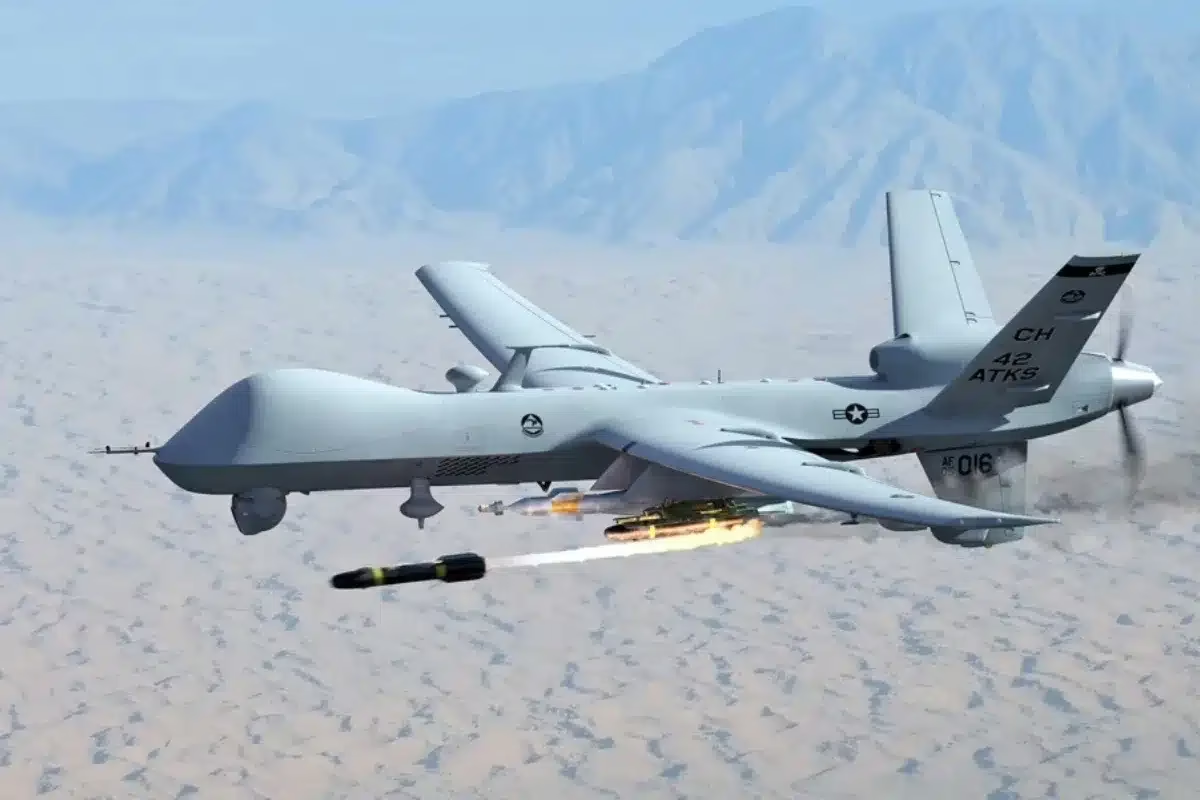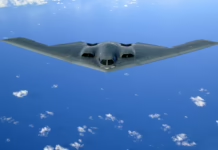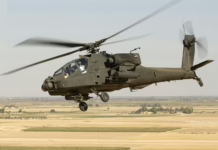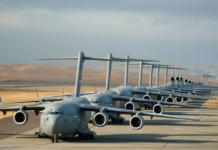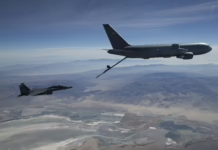Partners target cost-sensitive markets with unmanned AEW platform offering extended endurance and multi-domain radar capability
General Atomics Aeronautical Systems and Saab are positioning their jointly developed MQ-9B airborne early warning variant as a disruptive force in a market historically dominated by high-cost manned platforms, with both companies citing strong international interest ahead of a planned mid-2026 first flight.
The partnership, announced at the Paris air show in June 2025, addresses what the companies characterize as a persistent capability gap: nations unable to afford traditional AEW&C systems but requiring the extended surveillance endurance and multi-domain detection capabilities such platforms provide. With 16-20 hr. mission profiles compared to the 12-hr. endurance of manned systems, and significantly lower operating costs, the partners believe they have identified a substantial untapped market segment.
“Several years ago, we looked at where is the gap in the market: where should there be additional capability,” says David Moden, senior sales director airborne early warning at Saab’s Surveillance business unit. Feedback from operators and nations priced out of manned AEW&C systems consistently pointed to requirements for “persistence, endurance” and reduced asset-level risk. “The unmanned air vehicle seemed to fit all of those check-boxes,” he notes.
The system integrates Saab’s pod-housed active electronically scanned array radar beneath each wing of GA-ASI’s medium-altitude, long-endurance platform, with an additional centerline pod housing data processing and associated equipment. Saab brings more than 35 years of AEW experience, with its technology deployed on over 30 manned platforms worldwide, including the Erieye ER radar used on the Bombardier Global 6000/6500-based GlobalEye system now operated by the United Arab Emirates, on order for Sweden and planned for purchase by France.
“AEW is the ideal mission for an unmanned, semi-autonomous vehicle,” says Satish Krishnan, GA-ASI’s vice president, MQ-9B international. “You know where the borders are and where the enemy aircraft can come from. We can do 16-20h of endurance, and are much cheaper to operate than manned platforms, so it gives you a force multiplier.”
Strategic Investment Philosophy
Both partners emphasize their willingness to invest ahead of formal customer requirements—a departure from the traditional defense prime contractor model of waiting for requests for proposals. “We, like Saab, had been looking for many years to find the ideal partner,” Krishnan said at the Dubai air show on Nov. 18. “The two companies have a very similar DNA—we invest ahead of need, unlike some traditional defense primes who might wait for a request for proposals. We have leaned forward and developed the application.”
GA-ASI aims to “deliver a persistent AEW&C solution to our global operators that will protect them against sophisticated cruise missiles as well as simple but dangerous drone swarms,” addressing threat environments that have evolved significantly in recent conflicts.
The system will demonstrate multi-domain capabilities spanning air, sea, and land detection, identification and tracking. “This is a truly multi-domain radar: air, sea, and land,” Moden says, noting the platform’s ability to simultaneously monitor objects across each sector.
Development Timeline and Customer Engagement
Integration work is currently underway in the U.S. to mount the pods and system on the MQ-9B, with the partners targeting first flight “in the summer of 2026” from GA-ASI’s Desert Horizon test site in Southern California. Prospective customers will participate in the demonstration flights.
“It is a very mature radar and a very mature aircraft,” Krishnan notes. “We have got the antennas in the lab, and people are working around the clock to get this integrated. We don’t expect a lot of challenges to go from our first flights to having a fieldable product.”
The timeline from potential order to operational capability is aggressive by defense industry standards. “With an order placed in 2026, we would have the first systems fielded and operational in 2029,” Moden says.
Initial flight demonstrations will focus on air-to-air mode, though the multi-domain architecture is designed to support simultaneous operations across multiple sectors. GA-ASI serves as prime contractor for the program.
Market Interest and Operational Concepts
While declining to specify which nations or regions have expressed procurement interest, both companies report substantial global engagement. “Every briefing we have done globally, there has been tremendous interest,” Krishnan says. Moden adds: “We have a significant amount of interest in many parts of the world for this system. We are actively engaging with those countries now, to not only show them the capability, but also listen to what their requirements are so we can further define what that roadmap is going to be.”
The partners envision diverse operational concepts depending on customer requirements. “We see some countries having this as a sole AEW capability, but we also see tremendous interest in this system as an extension to a manned AEW platform, for manned-unmanned teaming,” Moden says.
Command and control integration will vary by customer: “Some customers will ask for a mission-proven command and control system, others will just have our data and take it down to their own system.” The platform will feature both line-of-sight connectivity and satellite communications.
Multiple MQ-9Bs could maintain constant orbital coverage through rotation or provide broader geographic surveillance. “Eyes in the sky forever—that’s what this enables,” Krishnan suggests.
Competitive Positioning
The development represents a potential market disruption for established AEW&C providers. Traditional systems from Boeing, Northrop Grumman, and other major defense contractors require substantially higher acquisition and operating costs, limiting their accessibility to nations with constrained defense budgets but facing growing air defense requirements.
Saab’s own GlobalEye program, based on ultra-long-range business jets, occupies a different market segment with 12-hour. mission endurance and higher capability but correspondingly higher costs. The companies appear to view the MQ-9B variant as complementary rather than competitive to existing manned platforms, particularly given the emphasis on manned-unmanned teaming concepts.
The investment-ahead-of-requirement approach carries commercial risk but potentially positions the partners ahead of emerging operational requirements, particularly as air forces globally grapple with expanding surveillance requirements amid budget constraints.
Carrier Variant on Horizon
Looking beyond the initial land-based configuration, the partners intend to offer the capability on an MQ-9B fitted with GA-ASI’s short takeoff and landing wing. That STOL variant, featured on the company’s Mojave demonstrator, could potentially support aircraft carrier operations.
The Mojave demonstrator conducted trials from the UK Royal Navy’s flagship vessel HMS Prince of Wales in November 2023, demonstrating the technical feasibility of carrier-based unmanned operations. In its Strategic Defence Review released earlier this year, the UK Ministry of Defence outlined ambitions for the Royal Navy’s two carriers to embark hybrid air wings combining unmanned aerial systems with manned platforms.
The UK Royal Air Force has already fielded a development of the MQ-9B under the Protector RG1 designation, with the type recently assuming frontline duties from the now-retired MQ-9 Reaper fleet. That existing operational relationship could provide a pathway for British consideration of the AEW variant, though the partners made no specific commitments regarding UK procurement interest.

Key Takeaways
- GA-ASI and Saab are developing an MQ-9B AEW&C variant targeting markets unable to afford traditional manned platforms, with first flight planned for summer 2026 and potential 2029 service entry.
- The system offers 16-20 hr. endurance compared to 12 hr. for manned platforms, with multi-domain radar capable of simultaneous air, sea and land detection at significantly lower operating costs.
- Both companies report “tremendous interest” globally, with some nations viewing it as a sole AEW capability and others pursuing manned-unmanned teaming concepts.
- A carrier-capable STOL variant is planned for future development, leveraging successful 2023 Mojave trials aboard HMS Prince of Wales and aligning with UK hybrid carrier air wing ambitions.



